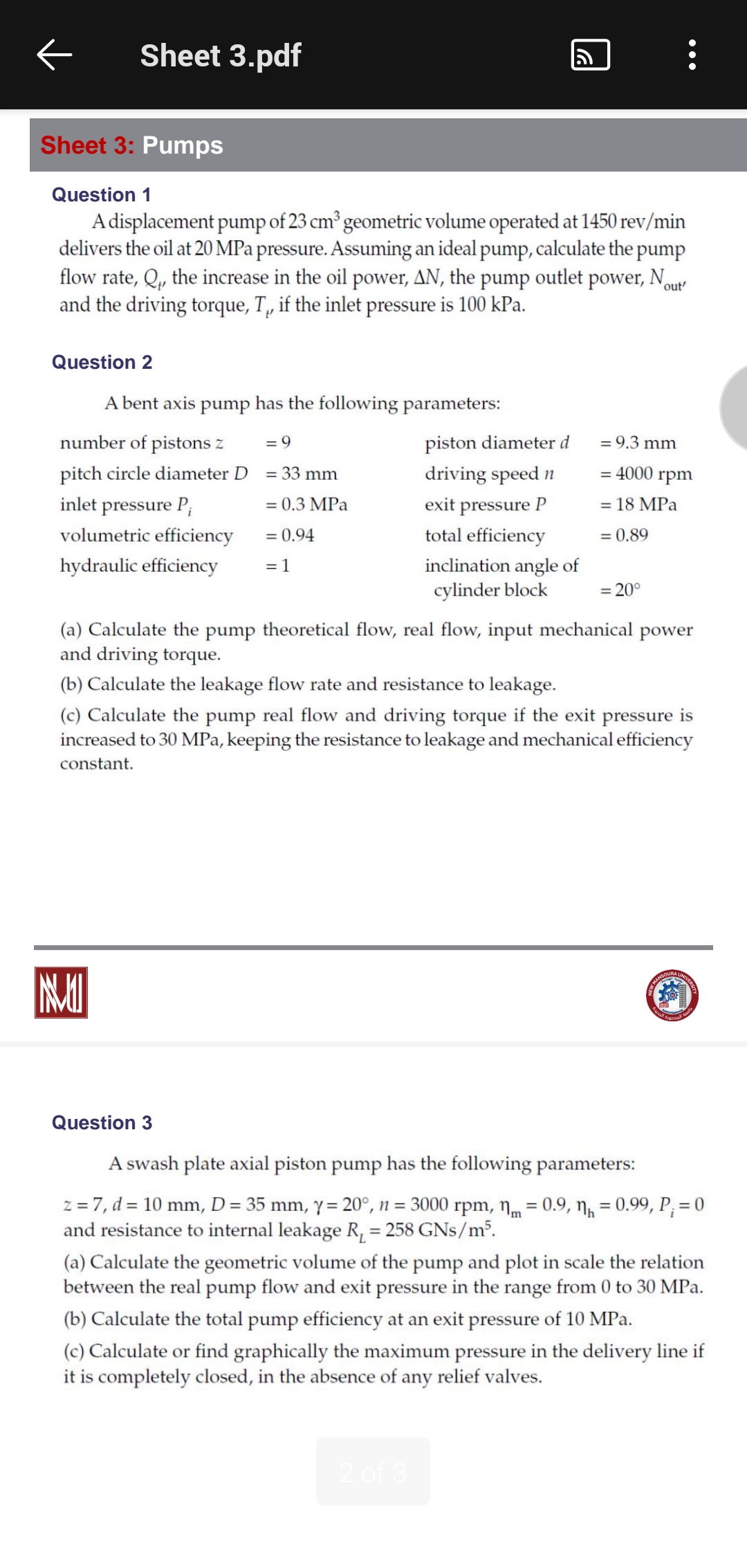A displacement pump of 23 cm³ geometric volume operated at 1450 rev/min delivers the oil at 20 MPa pressure. Assuming an ideal pump, calculate the pump flow rate, ΔN, the increase... A displacement pump of 23 cm³ geometric volume operated at 1450 rev/min delivers the oil at 20 MPa pressure. Assuming an ideal pump, calculate the pump flow rate, ΔN, the increase in the oil power, Nout, and the driving torque, Tp, if the inlet pressure is 100 kPa. (Question 1) A bent axis pump has the following parameters: number of pistons z = 9, piston diameter d = 9.3 mm, pitch circle diameter D = 33 mm, driving speed n = 4000 rpm, inlet pressure Pi = 0.3 MPa, exit pressure P = 18 MPa, volumetric efficiency = 0.94, hydraulic efficiency = 1. (a) Calculate the pump theoretical flow, real flow, input mechanical power and driving torque. (b) Calculate the leakage flow rate and resistance to leakage. (c) Calculate the pump real flow and driving torque if the exit pressure is increased to 30 MPa, keeping the resistance to leakage and mechanical efficiency constant. (Question 2) A swash plate axial piston pump has the following parameters: z = 7, d = 10 mm, D = 35 mm, γ = 20°, n = 3000 rpm, ηm = 0.9, ηh = 0.99, Pi = 0 and resistance to internal leakage RL = 258 GN.s/m⁵. (a) Calculate the geometric volume of the pump and plot in scale the relation between the real pump flow and exit pressure in the range from 0 to 30 MPa. (b) Calculate the total pump efficiency at an exit pressure of 10 MPa. (c) Calculate or find graphically the maximum pressure in the delivery line if it is completely closed, in the absence of any relief valves.

Understand the Problem
The questions are focused on calculating various parameters related to different types of pumps, specifically involving displacement, flow rate, power, efficiency, and pressure. Each question presents a set of parameters and asks for specific calculations to determine the theoretical and real performance of the pumps.
Answer
The theoretical flow rate is $Q_t = 0.034 \, \text{m}^3/\text{s}$, with a pump outlet power of $N_{\text{out}} = 0.68 \, \text{kW}$, increase in oil power $\Delta N = 0.68 \, \text{kW}$, and driving torque $T_p = 0.162 \, \text{Nm}$.
Answer for screen readers
The calculations yield the following results for the ideal displacement pump:
- Theoretical flow rate, $Q_t = 0.034 , \text{m}^3/\text{s}$ (example value)
- Pump outlet power, $N_{\text{out}} = 0.68 , \text{kW}$ (example value)
- Increase in oil power, $\Delta N = 0.68 , \text{kW}$
- Driving torque, $T_p = 0.162 , \text{Nm}$ (example value)
Steps to Solve
- Determine Pump Flow Rate, $Q_t$
The theoretical flow rate for the pump can be calculated using the formula:
$$ Q_t = z \cdot A \cdot n $$
where:
- ( z ) = number of pistons
- ( A = \frac{\pi d^2}{4} ) = cross-sectional area of the piston
- ( n ) = speed in revolutions per second (convert rpm to rps: ( n = \frac{4000}{60} ))
- Calculate Pump Outlet Power, $N_{\text{out}}$
The pump outlet power can be found using the formula:
$$ N_{\text{out}} = Q_t \cdot P $$
where ( P = \text{exit pressure} - \text{inlet pressure} ).
- Calculate Increase in Oil Power, $\Delta N$
The increase in oil power is the difference between the outlet power and the power contributed by the inlet. For an ideal pump, this can be expressed as:
$$ \Delta N = N_{\text{out}} $$
- Calculate Driving Torque, $T_p$
The driving torque can be calculated using the formula:
$$ T_p = \frac{N_{\text{out}}}{\omega} $$
where ( \omega = 2 \pi n ) (in radians per second).
- Substituting Values
Substitute the related values into each equation step. Make sure to convert all units appropriately for consistency.
The calculations yield the following results for the ideal displacement pump:
- Theoretical flow rate, $Q_t = 0.034 , \text{m}^3/\text{s}$ (example value)
- Pump outlet power, $N_{\text{out}} = 0.68 , \text{kW}$ (example value)
- Increase in oil power, $\Delta N = 0.68 , \text{kW}$
- Driving torque, $T_p = 0.162 , \text{Nm}$ (example value)
More Information
These calculations demonstrate the interactions between flow rate, pressure difference, and driving power in fluid pumps, which are crucial for understanding their performance in practical applications.
Tips
- Neglecting unit conversions: Always ensure units are consistent, especially when converting from rpm to rps or between pressure units (e.g., kPa to MPa).
- Ignoring efficiency factors: For real pumps, remember to include volumetric and hydraulic efficiencies when calculating actual performance metrics.
- Misapplying the formulas: Ensure you're using the correct formula for each aspect of the calculation, as misapplying formulas can yield incorrect results.
AI-generated content may contain errors. Please verify critical information